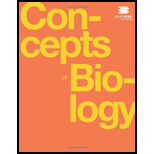
Concepts of Biology
1st Edition
ISBN: 9781938168116
Author: Samantha Fowler, Rebecca Roush, James Wise
Publisher: OpenStax College
expand_more
expand_more
format_list_bulleted
Concept explainers
Textbook Question
Chapter 14, Problem 10RQ
What adaptation do seed plants have in addition to the seed that is not found in seedless plants?
a. gametophytes
b. vascular tissue
c. pollen
d. chlorophyll
Expert Solution & Answer
Trending nowThis is a popular solution!

Students have asked these similar questions
What is the difference between Uniporters, Symporters and Antiporters? Which of these are examples of active transport?
What are coupled transporters?
What are “domains” and how do they aid in protein function?
Chapter 14 Solutions
Concepts of Biology
Ch. 14 - Figure 14.19 At what stage does the diploid zygote...Ch. 14 - Figure 14.26 If a flower lacked a megasporangium,...Ch. 14 - The land plants are probably descendants of which...Ch. 14 - The event that leads from the haploid stage to the...Ch. 14 - Moss is an example of which type of plant? a....Ch. 14 - Why do mosses grow well in the Arctic tundra? a....Ch. 14 - Which is the most diverse group of seedless...Ch. 14 - Which group are vascular plants? a. liverworts b....Ch. 14 - Which of the following traits characterizes...Ch. 14 - What adaptation do seed plants have in addition to...
Ch. 14 - Pollen grains develop in which structure? a. the...Ch. 14 - Corn develops from a seedling with a single...Ch. 14 - What adaptations do plants have that allow them to...Ch. 14 - What are the three classes of bryophytes?Ch. 14 - How did the development of a vascular system...Ch. 14 - What are the four modern-day groups of...Ch. 14 - Cycads are considered endangered species and their...Ch. 14 - What are the two structures that allow angiosperms...
Additional Science Textbook Solutions
Find more solutions based on key concepts
Distinguish between microevolution, speciation, and macroevolution.
Campbell Essential Biology (7th Edition)
Raw Oysters and Antacids: A Deadly Mix? The highly acidic environment of the stomach kills most bacteria before...
Microbiology with Diseases by Body System (5th Edition)
Why is living epithelial tissue limited to a certain thickness?
Human Anatomy & Physiology (2nd Edition)
Endospore formation is called (a) _____. It is initiated by (b) _____. Formation of a new cell from an endospor...
Microbiology: An Introduction
2. Whether an allele is dominant or recessive depends on
a. how common the allele is, relative to other alleles...
Campbell Biology: Concepts & Connections (9th Edition)
True or false? Some trails are considered vestigial because they existed long ago.
Biological Science (6th Edition)
Knowledge Booster
Learn more about
Need a deep-dive on the concept behind this application? Look no further. Learn more about this topic, biology and related others by exploring similar questions and additional content below.Similar questions
- What are intrinsically disordered proteins, and how might they be useful for a living system?arrow_forwardWhat are Amyloid Fibrils? What biological functions are these known to perform?arrow_forwardHow do histamine and prostaglandins help in the mobilization of leukocytes to an injury site? What are chemotactic factors? How do they affect inflammation process?arrow_forward
- Compare and contrast neutrophils and macrophages. Describe two ways they are different and two ways they are similar.arrow_forwardDescribe the effects of three cytokines (not involved in the initial inflammation response). What cells release them?arrow_forwardDescribe activation of helper T cells or cytotoxic T cellsarrow_forward
- Compare and contrast MHC 1 and MHC 2. Describe two way they are different and two ways they similar including how they are used in antigen presentation.arrow_forwardDescribe two antimicrobial properties of the skin.arrow_forwardDescribe how the inflammation response starts including the sentinel cells and the chemicals involved. How do pathogens trigger the response particularly in the skin?arrow_forward
- How does complement promote the immune response? Describe three waysarrow_forwardWhich of the following is not a possible mechanism for autoimmunity? Select one: A. Abnormal expression of MHC II molecules in non-antigen-presenting cells B. Activation of polyclonal B cells C. Polymorphism of HLA alleles D. Molecular mimicry E. Release of sequestered antigensarrow_forwardWRITTEN WORK 3: NON-MENDELIAN GENETICS Part A: Complete the Punnett square and calculate for the probability of genotype and phenotype. i i Genotype: Phenotype: 08:55arrow_forward
arrow_back_ios
SEE MORE QUESTIONS
arrow_forward_ios
Recommended textbooks for you
 Concepts of BiologyBiologyISBN:9781938168116Author:Samantha Fowler, Rebecca Roush, James WisePublisher:OpenStax College
Concepts of BiologyBiologyISBN:9781938168116Author:Samantha Fowler, Rebecca Roush, James WisePublisher:OpenStax College
 Biology: The Dynamic Science (MindTap Course List)BiologyISBN:9781305389892Author:Peter J. Russell, Paul E. Hertz, Beverly McMillanPublisher:Cengage Learning
Biology: The Dynamic Science (MindTap Course List)BiologyISBN:9781305389892Author:Peter J. Russell, Paul E. Hertz, Beverly McMillanPublisher:Cengage Learning Biology (MindTap Course List)BiologyISBN:9781337392938Author:Eldra Solomon, Charles Martin, Diana W. Martin, Linda R. BergPublisher:Cengage Learning
Biology (MindTap Course List)BiologyISBN:9781337392938Author:Eldra Solomon, Charles Martin, Diana W. Martin, Linda R. BergPublisher:Cengage Learning

Concepts of Biology
Biology
ISBN:9781938168116
Author:Samantha Fowler, Rebecca Roush, James Wise
Publisher:OpenStax College


Biology: The Dynamic Science (MindTap Course List)
Biology
ISBN:9781305389892
Author:Peter J. Russell, Paul E. Hertz, Beverly McMillan
Publisher:Cengage Learning

Biology (MindTap Course List)
Biology
ISBN:9781337392938
Author:Eldra Solomon, Charles Martin, Diana W. Martin, Linda R. Berg
Publisher:Cengage Learning
DIVERSITY IN PLANTS; Author: 7activestudio;https://www.youtube.com/watch?v=uJrks56FQIY;License: Standard YouTube License, CC-BY
Biology- Plant Kingdom - Diversity in Living Organisms - Part 4 - English - English; Author: Bodhaguru;https://www.youtube.com/watch?v=QFgQ74EvfDQ;License: Standard YouTube License, CC-BY